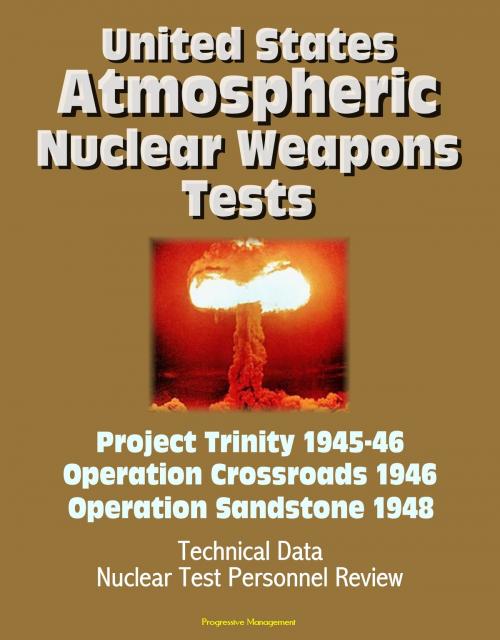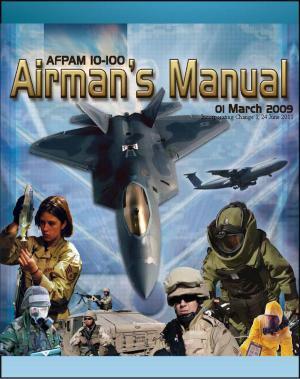United States Atmospheric Nuclear Weapons Tests: Project Trinity 1945-46, Operation Crossroads 1946, Operation Sandstone 1948 - Technical Data, Nuclear Test Personnel Review
Nonfiction, History, Military, Nuclear Warfare| Author: | Progressive Management | ISBN: | 9781311898111 |
| Publisher: | Progressive Management | Publication: | April 15, 2014 |
| Imprint: | Smashwords Edition | Language: | English |
| Author: | Progressive Management |
| ISBN: | 9781311898111 |
| Publisher: | Progressive Management |
| Publication: | April 15, 2014 |
| Imprint: | Smashwords Edition |
| Language: | English |
Three fascinating reports from the U.S. government provide exclusive details about early American atmospheric atomic tests: Trinity (the first atomic weapon ever exploded), Crossroads, and Sandstone.
Project Trinity 1945-1946 - United States Atmospheric Nuclear Weapons Tests - Nuclear Test Personnel Review - This report describes the activities of an estimated 1,000 personnel, both military and civilian, in Project TRINITY, which culminated in detonation of the first nuclear device, in New Mexico in 1945. Scientific and diagnostic experiments to evaluate the effects of the nuclear device were the primary activities engaging military personnel.
Operation Crossroads 1946 - United States Atmospheric Nuclear Weapons Tests - Nuclear Test Personnel Review - Crossroads was the first peacetime nuclear weapons test series. It was conducted at Bikini Atoll in 1946. Report emphasis is on the radiological safety of the personnel. Available records on personnel exposure are summarized. Operation CROSSROADS was an atmospheric nuclear weapon test series conducted in the summer of 1946. The series consisted of two detonations, each with a yield of 23 KT: ABLE — detonated at an altitude of 520 feet (158 meters) on 1 July * BAKER — detonated 90 feet (27 meters) underwater on 25 July. It was the first nuclear test held in the Marshall Islands. The series was to study the effects of nuclear weapons on ships, equipment, and material. A fleet of more than 90 vessels was assembled in Bikini Lagoon as a target. This target fleet consisted of older U.S. capital ships, three captured German and Japanese ships, surplus U.S. cruisers, destroyers and submarines, and a large number of auxiliary and amphibious vessels. Military equipment was arrayed on some of the ships as well as amphibious craft that were beached on Bikini Island. Technical experiments were also conducted to study nuclear weapon explosion phenomena. Some experiments included the use of live animals. The support fleet of more than 150 ships provided quarters, experimental stations, and workshops for most of the 42,000 men (more than 37,000 of whom were Navy personnel) of Joint Task Force 1 (JTF 1), the organization that conducted the tests. Additional personnel were located on nearby atolls such as Enewetak and Kwajalein. The islands of the Bikini Atoll were used primarily as recreation and instrumentation sites.
SANDSTONE was a three-detonation nuclear weapon test series held at Enewetak Atoll, the Atomic Energy Commission's (AEC) Pacific Proving Ground (PPG), in the spring of 1948. Located in the Central Pacific Ocean, the PPG consisted principally of Enewetak and Bikini atolls in the northwestern Marshall Islands. X-RAY / 15 April / 200-foot (61-meter) tower on Enjebl Island / 37 * YOKE / 1 May / 200-foot (61-meter) tower on Aomon Island / 49 * ZEBRA / 15 May / 200-foot (61-meter) tower on Runit Island 18
Operation SANDSTONE was the second test series to be held in the Marshall Islands, but it differed from the first series (CROSSROADS in 1946) in that it was primarily an AEC scientific test series with the armed forces serving in a supporting role. Its purpose was to proof-test improved-design atomic weapons, whereas the purpose of CROSSROADS was to test nuclear weapons effects on ships. The weapons were tested at Enewetak by a joint military and civilian organization designated Joint Task Force 7 (JTF 7). This was a military organization in form, but contained military, civil service, and contractor personnel of the Department of Defense (DOD) and the AEC. The commander of this force was the appointed representative of the AEC and reported to both the Joint Chiefs of Staff and the Commander in Chief, Pacific.
Three fascinating reports from the U.S. government provide exclusive details about early American atmospheric atomic tests: Trinity (the first atomic weapon ever exploded), Crossroads, and Sandstone.
Project Trinity 1945-1946 - United States Atmospheric Nuclear Weapons Tests - Nuclear Test Personnel Review - This report describes the activities of an estimated 1,000 personnel, both military and civilian, in Project TRINITY, which culminated in detonation of the first nuclear device, in New Mexico in 1945. Scientific and diagnostic experiments to evaluate the effects of the nuclear device were the primary activities engaging military personnel.
Operation Crossroads 1946 - United States Atmospheric Nuclear Weapons Tests - Nuclear Test Personnel Review - Crossroads was the first peacetime nuclear weapons test series. It was conducted at Bikini Atoll in 1946. Report emphasis is on the radiological safety of the personnel. Available records on personnel exposure are summarized. Operation CROSSROADS was an atmospheric nuclear weapon test series conducted in the summer of 1946. The series consisted of two detonations, each with a yield of 23 KT: ABLE — detonated at an altitude of 520 feet (158 meters) on 1 July * BAKER — detonated 90 feet (27 meters) underwater on 25 July. It was the first nuclear test held in the Marshall Islands. The series was to study the effects of nuclear weapons on ships, equipment, and material. A fleet of more than 90 vessels was assembled in Bikini Lagoon as a target. This target fleet consisted of older U.S. capital ships, three captured German and Japanese ships, surplus U.S. cruisers, destroyers and submarines, and a large number of auxiliary and amphibious vessels. Military equipment was arrayed on some of the ships as well as amphibious craft that were beached on Bikini Island. Technical experiments were also conducted to study nuclear weapon explosion phenomena. Some experiments included the use of live animals. The support fleet of more than 150 ships provided quarters, experimental stations, and workshops for most of the 42,000 men (more than 37,000 of whom were Navy personnel) of Joint Task Force 1 (JTF 1), the organization that conducted the tests. Additional personnel were located on nearby atolls such as Enewetak and Kwajalein. The islands of the Bikini Atoll were used primarily as recreation and instrumentation sites.
SANDSTONE was a three-detonation nuclear weapon test series held at Enewetak Atoll, the Atomic Energy Commission's (AEC) Pacific Proving Ground (PPG), in the spring of 1948. Located in the Central Pacific Ocean, the PPG consisted principally of Enewetak and Bikini atolls in the northwestern Marshall Islands. X-RAY / 15 April / 200-foot (61-meter) tower on Enjebl Island / 37 * YOKE / 1 May / 200-foot (61-meter) tower on Aomon Island / 49 * ZEBRA / 15 May / 200-foot (61-meter) tower on Runit Island 18
Operation SANDSTONE was the second test series to be held in the Marshall Islands, but it differed from the first series (CROSSROADS in 1946) in that it was primarily an AEC scientific test series with the armed forces serving in a supporting role. Its purpose was to proof-test improved-design atomic weapons, whereas the purpose of CROSSROADS was to test nuclear weapons effects on ships. The weapons were tested at Enewetak by a joint military and civilian organization designated Joint Task Force 7 (JTF 7). This was a military organization in form, but contained military, civil service, and contractor personnel of the Department of Defense (DOD) and the AEC. The commander of this force was the appointed representative of the AEC and reported to both the Joint Chiefs of Staff and the Commander in Chief, Pacific.















